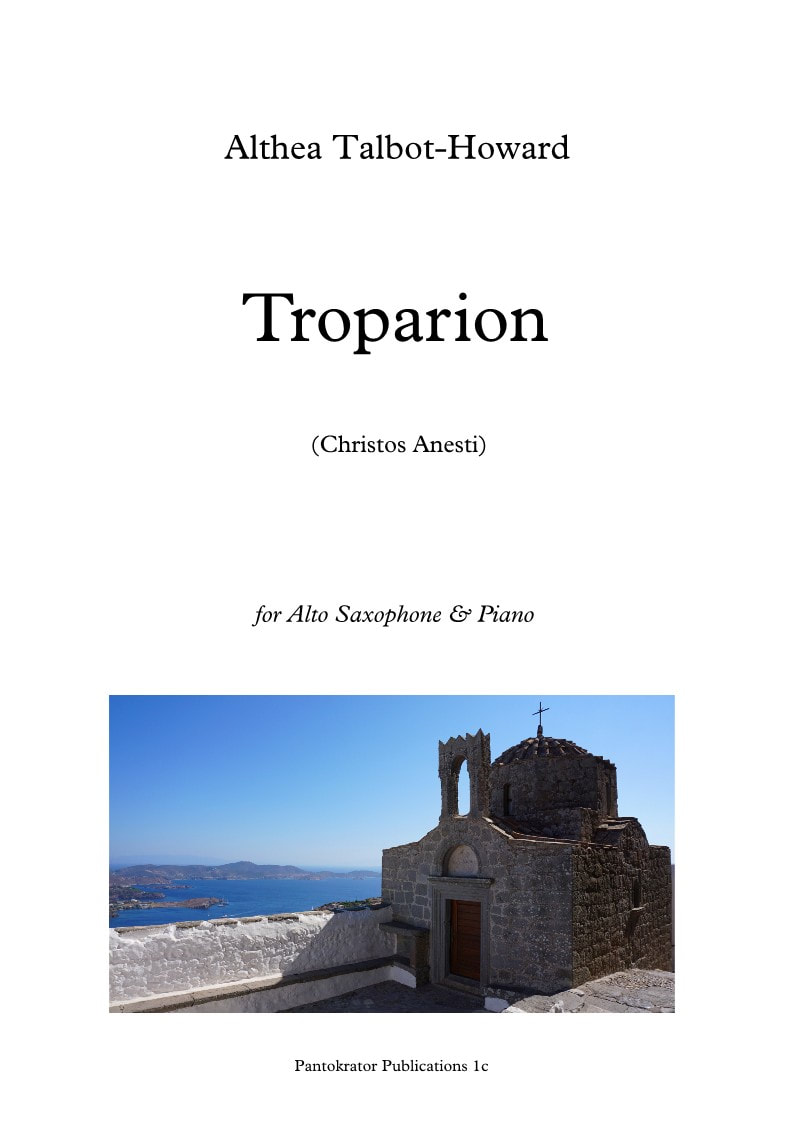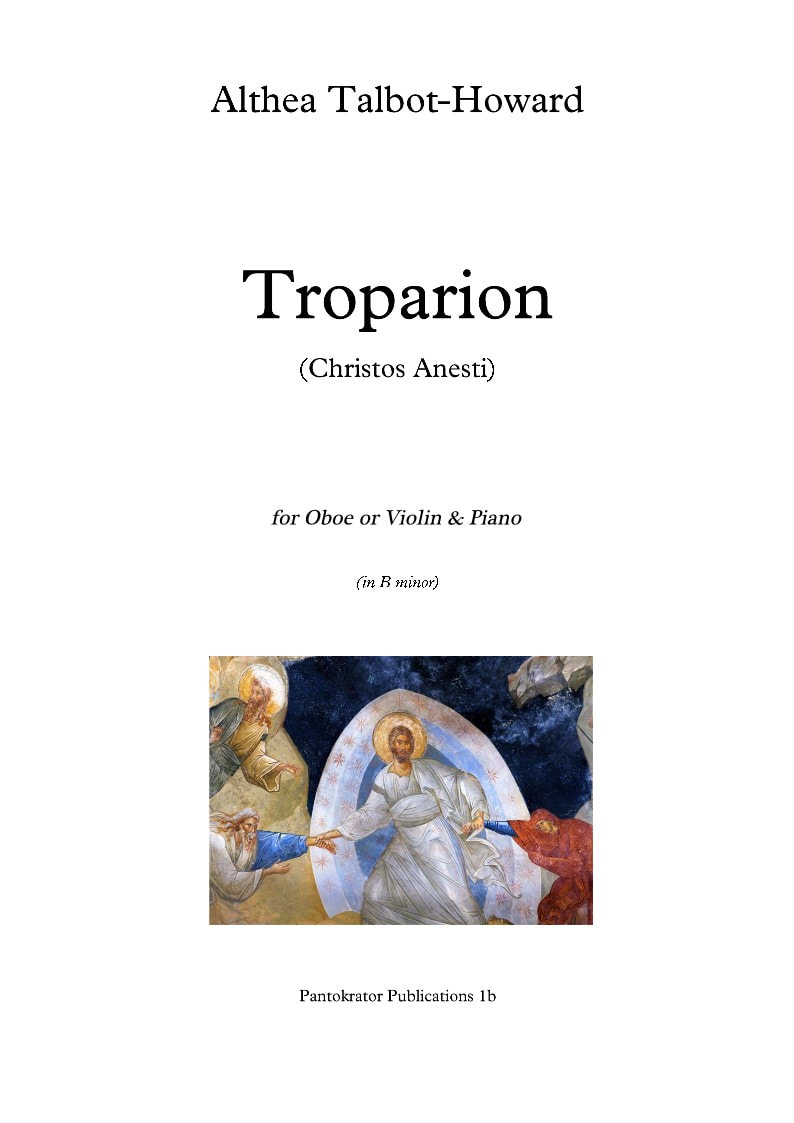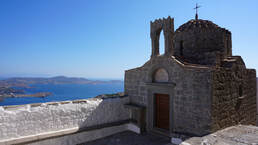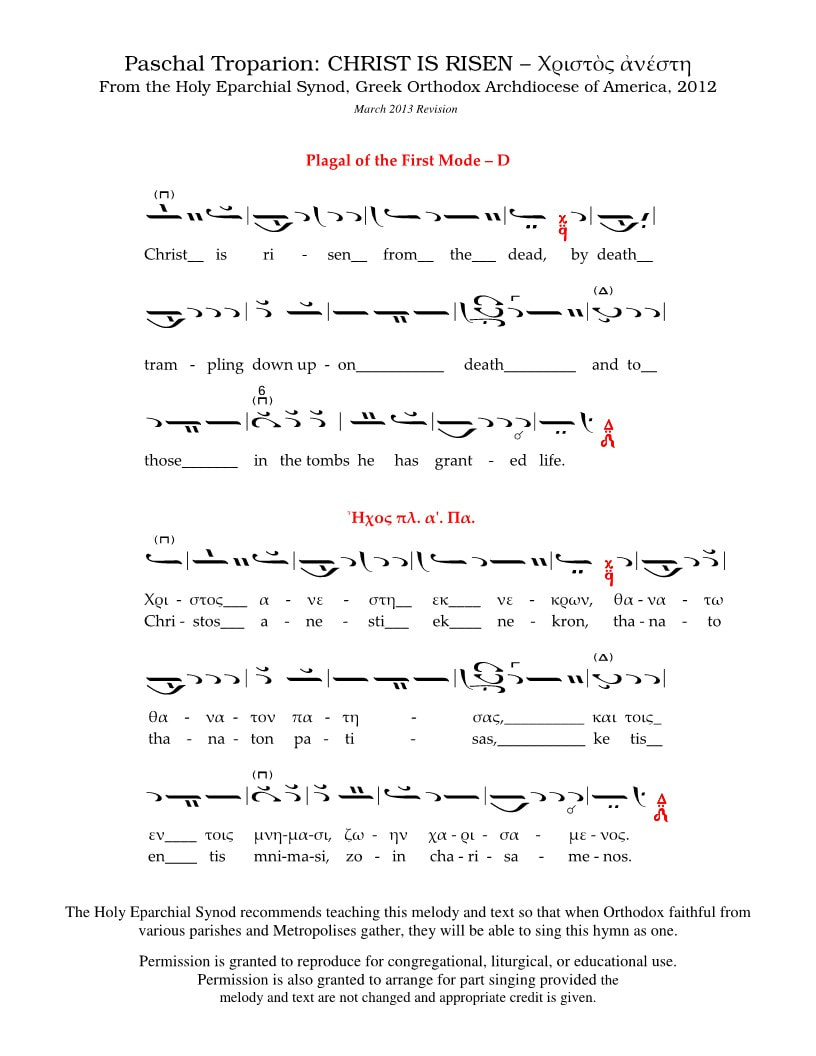|
|
|
To purchase Troparion from June Emerson Wind Music, please click on the image of the Alto Saxophone or Oboe/Violin score.
|
Troparion
for Solo Melody Instrument & Piano Level: Moderately Advanced Duration: 3'20" Scores available: B minor for Oboe or Violin Eb minor for Alto Saxophone Click on the images, to purchase these scores Eb minor for Flute, Treble Recorder, Clarinet in A, Oboe d'amore Please send a message via the Contact Page |
The recordings below are with Modern Alto Recorder, Alto Saxophone, Oboe d'amore & Oboe, respectively.
|
|
|
|
|
|
Troparion (2018) is a short, lyrical, multi-instrumental work inspired by - and incorporating - Byzantine Orthodox chant.
A troparion is a chanted hymn of one stanza. The chant concerned is Christos Anesti - the famous paschal (Easter) monody dating back to at least the sixth century A.D., and possibly as far back as the second.
Structure: A1, B1, A2, B2, Coda
After the opening apechema*, which functions here as a short, introductory declamation, the melody instrument plays the chant, accompanied by the piano. This comprises the A1 section. The next section - B1 - consists entirely of my music, composed as an answer to the gestures, spirit, emotion and decorative rhythms of the original chant. B1 and A2 are joined by a re-statement of the apechema, before the A2 section begins. Here the chant can be heard once more in the right hand of the piano part, whilst the melody instrument plays a contrapuntal line composed by me. The B2 section is again, all mine. The piece concludes with a short coda, utilising the apechematic material.
*The apechema is sung by the cantor, to show the range of the mode, and whether it is authentic or plagal. The apechema at the beginning of Troparion is 'A-ne-a-nes' (Dorian mode, plagal form).
A troparion is a chanted hymn of one stanza. The chant concerned is Christos Anesti - the famous paschal (Easter) monody dating back to at least the sixth century A.D., and possibly as far back as the second.
Structure: A1, B1, A2, B2, Coda
After the opening apechema*, which functions here as a short, introductory declamation, the melody instrument plays the chant, accompanied by the piano. This comprises the A1 section. The next section - B1 - consists entirely of my music, composed as an answer to the gestures, spirit, emotion and decorative rhythms of the original chant. B1 and A2 are joined by a re-statement of the apechema, before the A2 section begins. Here the chant can be heard once more in the right hand of the piano part, whilst the melody instrument plays a contrapuntal line composed by me. The B2 section is again, all mine. The piece concludes with a short coda, utilising the apechematic material.
*The apechema is sung by the cantor, to show the range of the mode, and whether it is authentic or plagal. The apechema at the beginning of Troparion is 'A-ne-a-nes' (Dorian mode, plagal form).
How I came to compose Troparion - A Personal Note
In the late 1990s, a friend invited me to attend a Holy Week service at St George's Orthodox Cathedral near Regent's Park, in London. The church belongs to the See of Antioch, and it was the first time I had ever attended an Orthodox service, so I was very interested and excited to go.
During the liturgy we sang 'Christ is risen from the dead' three times through, in three different places in the church. By the end of the service I had memorised the tune, and it stayed with me.
Decades later, when I had become a composer, I looked it up on YouTube. I quickly found out that there was more than one chant melody for this text, and that the major mode version I had learned was not the only one. In fact, the principal chant is in (Orthodox) Tone One - the Dorian mode.
A quick note to colleagues: mode theory is difficult, per se. But it becomes incredibly difficult when one discovers that there are not two, but three different schools of thought and praxis about modes. In Western (Gregorian) mode theory, Mode/Tone 1 is the Ionian mode, and Mode 2 is the Dorian mode. In Byzantine Orthodox mode theory, Mode 1 is Dorian.
In the late 1990s, a friend invited me to attend a Holy Week service at St George's Orthodox Cathedral near Regent's Park, in London. The church belongs to the See of Antioch, and it was the first time I had ever attended an Orthodox service, so I was very interested and excited to go.
During the liturgy we sang 'Christ is risen from the dead' three times through, in three different places in the church. By the end of the service I had memorised the tune, and it stayed with me.
Decades later, when I had become a composer, I looked it up on YouTube. I quickly found out that there was more than one chant melody for this text, and that the major mode version I had learned was not the only one. In fact, the principal chant is in (Orthodox) Tone One - the Dorian mode.
A quick note to colleagues: mode theory is difficult, per se. But it becomes incredibly difficult when one discovers that there are not two, but three different schools of thought and praxis about modes. In Western (Gregorian) mode theory, Mode/Tone 1 is the Ionian mode, and Mode 2 is the Dorian mode. In Byzantine Orthodox mode theory, Mode 1 is Dorian.
|
What makes Christos Anesti so interesting - apart from its spiritual impact - is its historicity. It connects with music used in synagogue worship at the time of Christ. One is hearing music which has not gone through the evolutionary (sic) process that is such a feature of Western music. This music has been transmitted largely unchanged, through the millennia.
Christos Anesti featured in liturgical worship in Hagia Sophia, Constantinople, by the tenth century A.D. In Orthodox chant, one generally hears two lines of music - the chant - and the ison. The ison is the lower part, which functions as a drone, normally remaining below the chant, and changing bass note only occasionally. It is normally sung without words, and features the mode final, co-final, mediant or participant (I, V, III or IV). In Troparion, the ison is represented by the piano's open-octave accompaniment. |
Building the Piece
The original key of composition is Eb minor, and the modelling instrument is the Modern Alto (Treble) Recorder, which is fully-chromatic, thus allowing for the inclusion of top Gb in passagework. Eb minor was chosen for two reasons. Firstly, the predominance of chromatic cross-fingerings on the Recorder in Eb minor creates a similar timbre to the sound of the chant, when sung authentically. The lack of resonance caused by covered tone holes was the sound I wished to create.
Secondly, part of my mission as a former recitalist who now composes such music for others, is to make original key choices in duo music. There are different ways of pushing boundaries, as a composer - and this is mine. How often does one play a recital piece in Eb or Bb minor? I had never played one, until I started composing them! These keys have beautiful sonorities, though, which it is a pleasure to explore, and which enhance the listener's experience of the music.
The original key of composition is Eb minor, and the modelling instrument is the Modern Alto (Treble) Recorder, which is fully-chromatic, thus allowing for the inclusion of top Gb in passagework. Eb minor was chosen for two reasons. Firstly, the predominance of chromatic cross-fingerings on the Recorder in Eb minor creates a similar timbre to the sound of the chant, when sung authentically. The lack of resonance caused by covered tone holes was the sound I wished to create.
Secondly, part of my mission as a former recitalist who now composes such music for others, is to make original key choices in duo music. There are different ways of pushing boundaries, as a composer - and this is mine. How often does one play a recital piece in Eb or Bb minor? I had never played one, until I started composing them! These keys have beautiful sonorities, though, which it is a pleasure to explore, and which enhance the listener's experience of the music.





